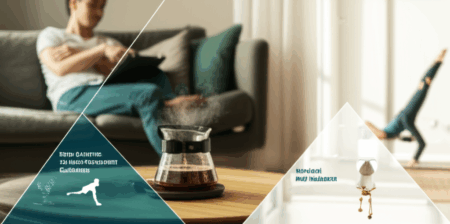Feeling perpetually wired yet tired? Struggling with morning grogginess, afternoon energy crashes, or restless nights despite exhaustion? The culprit might not be a lack of sleep, but rather a disrupted cortisol rhythm. Far from being solely a “stress hormone,” cortisol is a crucial player in orchestrating your daily energy, focus, and even immune function. According to Dr. Andrew Huberman, a neuroscientist and tenured professor at Stanford School of Medicine, correctly setting your 24-hour cortisol rhythm is one of the most powerful levers you have for transforming your physical and mental well-being.
Dr. Huberman emphasizes that the ideal cortisol pattern involves a sharp peak shortly after waking, followed by a gradual decline throughout the day, reaching its lowest levels before and during the initial hours of sleep. This natural rhythm, controlled by the hypothalamic-pituitary-adrenal (HPA) axis and synchronized by light cues, is essential for robust daytime alertness, mood regulation, and restorative sleep. When this delicate balance is disturbed, it can lead to a host of issues, including burnout, anxiety, poor focus, and compromised sleep quality. The good news? Huberman provides a suite of actionable, science-based protocols—encompassing behavioral adjustments, nutritional strategies, and targeted supplementation—to help you reset and optimize your cortisol levels for peak performance.

Mastering Your Morning: Boosting Healthy Cortisol
The first two hours after waking are paramount for setting your cortisol rhythm for the entire day, preventing a “flattened” cortisol curve that can leave you feeling drained. The goal is to encourage a strong, healthy cortisol spike early on.
Embrace Morning Sunlight Exposure
This is arguably the most critical behavioral tool Dr. Huberman advocates. Viewing natural light within the first hour (ideally within 30 minutes) of waking, for 5-10 minutes, is a powerful signal to your brain to initiate a healthy cortisol release.
- Go Outside: Even on cloudy days, the photon count from natural light is significantly higher than artificial indoor lighting. Step outside without sunglasses; eyeglasses and contacts are fine.
- Look Towards the Sun (Don’t Stare): Look in the general direction of the sun, blinking as needed, to avoid eye damage.
- If Outdoors Isn’t Possible: If natural sunlight is unavailable, a 10,000 LUX artificial light source can be used, though natural light is always preferred.
This early light exposure not only boosts morning cortisol, enhancing alertness, mood, and metabolism, but also positively influences your sleep quality later that night by reinforcing your circadian rhythm.
Hydrate Immediately Upon Waking
Proper hydration is often an underrated protocol for overall health and performance. Dr. Huberman suggests drinking 16-32 ounces of water with electrolytes immediately after waking to support optimal brain and body function.
Strategic Caffeine Timing
While many reach for coffee first thing, Huberman recommends delaying caffeine intake by 60-90 minutes (or even up to 120 minutes) after waking. This allows your natural cortisol spike to occur without interference, preventing an abrupt drop in energy levels later in the afternoon.
Incorporate Early Day Movement and Cold Exposure
- Morning Exercise: Engaging in regular exercise, ideally in the morning or early afternoon, can increase cortisol and serve as a crucial cue for your body’s circadian clock. Consistency in timing is more important than the specific type of exercise.
- Deliberate Cold Exposure: Short bursts of cold exposure, such as cold showers or ice plunges (1-2 times per week), can rapidly increase adrenaline and dopamine, promoting alertness and focus that lasts for hours. While initially raising cortisol, habitual exposure can diminish this effect over time.
Utilize Non-Sleep Deep Rest (NSDR) or Yoga Nidra
For individuals who wake up feeling highly stressed or whose cortisol is rising too quickly, Huberman suggests practicing Non-Sleep Deep Rest (NSDR) or Yoga Nidra for 10-35 minutes right after waking. These practices engage the parasympathetic nervous system, helping to gently reduce the steepness of the morning cortisol increase, replenish dopamine, and decrease overall stress.

Navigating the Afternoon: Maintaining Balance
As the day progresses, your cortisol levels should naturally begin their gradual decline. The goal in the afternoon is to avoid actions that could cause an unnecessary spike or disrupt this downward trend.
Afternoon Movement
A short walk in the afternoon can be beneficial, particularly if done outdoors to continue getting natural light exposure which supports circadian rhythm.
Meal Timing and Composition
Huberman often discusses a low-carbohydrate approach for morning and afternoon meals to maintain alertness and focus. However, he makes a distinction for evening meals.

Winding Down: Lowering Cortisol for Restorative Sleep
Optimizing your evening routine to lower cortisol is critical for transitioning into restful sleep. If evening cortisol levels remain high, it can lead to difficulties falling asleep and a feeling of “wired but tired.”
Strategic Light Management
Light exposure, especially short-wavelength blue and green light, significantly impacts melatonin production and can increase cortisol in the evening.
- Dim Indoor Lights: As much as possible, dim indoor lights, particularly overhead lighting, 1-2 hours before bed. Table lamps or floor lights are preferable to overhead lights because of how light-sensing neurons in the eye are distributed.
- Avoid Blue and Green Light from Screens: Minimize exposure to blue and green light from phones, computers, and tablets. Many devices have “night shift” or red-light filter settings that can be activated. Some individuals opt for blue-light blocking glasses.
Evening Nutrition: The Power of Carbohydrates
Counterintuitively for some, Huberman suggests that consuming starchy carbohydrates (like pasta or rice) in the evening can help lower cortisol levels. This is because carbohydrates facilitate a pathway involving the amino acid tryptophan, which converts to serotonin, a precursor to melatonin, thus effectively blunting the cortisol response and aiding relaxation and sleep. He also advises avoiding excessive meat consumption before bed due to longer gastric clearance times.
Behavioral Tools for Real-Time Stress Reduction
Even with an optimized daily routine, stress can arise. Huberman offers a powerful, immediate tool for managing acute stress responses and lowering cortisol:
- The Physiological Sigh: This breathing technique involves a double inhale through the nose, followed by a long, complete exhale through the mouth. It’s a natural human and animal reflex performed spontaneously to offload carbon dioxide and rapidly calm the nervous system by activating the parasympathetic system. Performing 1-3 physiological sighs can quickly reduce your stress level in real-time.
The Importance of Consistent Sleep Schedule
Beyond specific evening habits, maintaining a consistent sleep-wake schedule is fundamental. Going to bed and waking up around the same time each day, even on weekends, helps to firmly entrain your circadian rhythm and, by extension, your cortisol pattern. A cool (65-68°F) and dark bedroom environment also promotes restorative sleep.
Targeted Supplementation for Cortisol Regulation
While emphasizing that supplements should complement, not replace, fundamental lifestyle changes, Huberman suggests a few that can assist in lowering evening cortisol and promoting sleep:
- Ashwagandha: Taken in the late afternoon or evening (300-600mg), Ashwagandha has been shown to modestly reduce cortisol levels.
- Apigenin: Found in chamomile, 50mg of Apigenin taken before sleep can aid in relaxation.
- Magnesium Threonate: This form of magnesium is part of Huberman’s recommended sleep stack due to its ability to improve sleep depth and quality.

The Broader Impact of Cortisol Rhythm on Health
Understanding and optimizing your cortisol rhythm goes beyond just feeling less stressed. A properly regulated cortisol pattern significantly impacts:
- Cognitive Function: Enhances daytime focus, alertness, and mental clarity.
- Immune System: Supports a healthy immune response.
- Metabolism: Plays a role in metabolic regulation.
- Mood: Contributes to stable mood and resilience against stress.
- Longevity: Disruptions to cortisol rhythm have been linked to aging and various health risks.
By meticulously aligning your daily behaviors with your body’s natural hormonal ebb and flow, as outlined by Dr. Andrew Huberman, you can unlock a profound transformation in your physical vitality, mental acuity, and overall well-being. The key lies in consistent, science-backed practices that support a healthy cortisol rhythm from sunrise to sunset.







